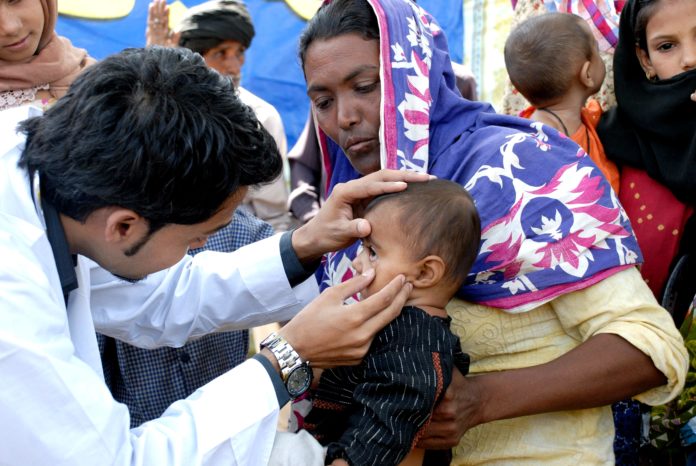As the war of words between health minister Dr Harsh Vardhan and Delhi CM Arvind Kejriwal rages, Medibulletin takes you through the two health schemes and their pros and cons
The battle lines have been drawn. With the letter war between Delhi chief minister Arvind Kejriwal and Union health minister having sounded the bugle for a face off between Ayushman Bharat and the Delhi Health Scheme, it is time to look at both. Ayushman Bharat – Pradhan Mantri Jan Arogya Yojana (PMJAY) is the world’s largest government funded health insurance programme. Delhi Health Scheme a three tiered programme that includes unlimited free treatment in a private hospital in case of a long waiting list at a government facility.
A lowdown on both – and the letters that started it all.
What triggered the war of words over the health schemes of the Centre and the state?
On June 5 immediately after taking charge as the health minister Dr Harsh Vardhan wrote to Kejriwal and the chief ministers of Odisha, Telangana and West Bengal that are yet to join the scheme. “As is clear – under your leadership, Onboarding of Delhi under AB-PMJAY shall be highly beneficial for the state, beneficiaries of the state as well as the overall AB-PMJAY scheme at the national level – and is therefore a win-win-win situation for all stakeholders. In the spirit of co-operative federalism I look forward to your support towards delhi joining AB-PMJAY for the common good of all and assure you of complete support from my end in this regard,” he wrote.
Kejriwal responded saying that the Delhi’s government health programme is “10 times better” than Ayushman Bharat. “Ayushman Bharat covers medical expenses upto Rs 5 lakhs, whereas Delhi government bears all the medical expenses, even if the bill runs up to Rs 30 lakhs or more,” Kejriwal wrote.
What is Ayushman Bharat-PMJAY?
The scheme looks to cover 10.74 crore families – 50 crore people – with an annual health cover of Rs 5 lakh. Eligibility is decided on the basis of data from the 2011 socio economic caste census (SECC). Till date, 3.62 crore beneficiary e-cards have been generated, a total of 27.86 lakh people across the country have been hospitalised under the scheme. A total of 1350 processes are covered under the scheme with some of them requiring pre-authorisation to prevent corruption. The scheme is currently on in 32 states and Union Territories. There are also health and wellness centres being set up under Ayushman Bharat as a preventive arm to offset the tertiary care focus of PMJAY.
What is the Delhi Health Scheme?
The three-tiered health scheme of Delhi government comprises Mohalla clinics, polyclinics and hospitals. So far 158 mohalla clinics are in place and the target is to set up 1000 more. There are 25 multispeciality polyclinics where specialists see patients. Another 150 are in the pipeline but the system, by the admission of Delhi health minister Satyendra Jain himself, are only functioning at ’10-15 percent.”
All medicines, tests and surgeries in the 38 hospitals in the city are free of cost. However if Delhi residents in need of a life-saving surgery have to wait for more than 30 days for treatment in these hospitals they are treated free of cost at a private hospital regardless of the cost of treatment or the income of the patient. That is why Kejriwal said that the Delhi health scheme is 10 times bigger than the health scheme of the Centre. It however, requires elaborate paperwork and it is not clear how many people have taken advantage of the scheme that was announced in July 2018.
Challenges before Ayushman Bharat
- Implementation depends to a large extent on the states
- Patchy coverage of health facilities across the country
- Lack of doctors outside of big cities
- The eligibility criteria is old and the SECC list has discrepancies
- Roping in private providers means quality control and moral hazard will be challenges
- Integration of PMJAY and health and wellness centres
Strengths of Ayushman Bharat
- World class fraud control measures
- Work is currently on for drawing up standard treatment guidelines
- There is constant monitoring directly by the prime minister’s office
- It will bring resources into the public health sector for government hospitals to up their game
- National portability – a card holder can avail health services in any state that is a part of the scheme
Challenges of Delhi Health Scheme
- The Mohalla Clinics are behind schedule
- They have already faced controversies over nepotism charges, some have closed down
- Doctors have been complaining of patient load and delays that have caused patients to either succumb or move out of the government system
- Availing treatment in private hospitals is a long and cumbersome process
- There is staff shortage
- The option of treatment in private hospitals is open to abuse – mere paperwork may not be the solution as that could lead to unnecessary delays
- Fraud control measures are not as robust as PMJAY
Strengths of Delhi Health Scheme
- It is universal
- It is a clear three tier structure with primary, secondary and tertiary components
- Unlike in many states, Delhi started off with emphasis on prevention through Mohalla Clinics
- Delhi has among the highest per capita doctors in the country
- There is, at least on paper no limit to free treatment at private hospitals – crucial because healthcare in Delhi is expensive


